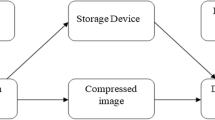Abstract
An efficient way of using Embedded Zero-trees of Wavelet (EZW) architecture for video compression, termed as “Two Threshold EZW”, has been introduced in this paper. This architecture is free from motion compensation and post-compression rate-distortion (PCRD) optimization algorithms. To catch up with the compression obtained by H.265, traditional EZW architecture has been modified for exploiting the temporal/inter-frame dependency. To exploit this, the concept of two thresholds for intra and inter-frame coding has been introduced for a single frame. It is also helpful in coding spatial high-pass and low-pass components independently, which adds more degree of freedom for rate optimization. This architecture makes it easier for achieving blind scalability without using PCRD optimization. To evaluate the algorithm, it has been compared with H.265 at different bit rates. Peak Signal to Noise Ratio (PSNR) and Structural Similarity (SSIM) index are calculated to compare the quality of reconstruction at various low bit rates.









Similar content being viewed by others
References
Badawy W, Weeks M, Zhang G, Talley M, Bayoumi MA (2002) Mri data compression using a 3-d discrete wavelet transform. IEEE Eng Med Biol Mag 21(4):95–103
Bernabé G, González J, García JM, Duato J (2002) Memory conscious 3d wavelet transform. In: Euromicro Conference, 2002. Proceedings. 28th, IEEE, pp 108–113
Chen Z, Pan X (2019) An optimized rate control for low-delay h. 265/hevc. IEEE Transactions on Image Processing
Collection D (2020) Xiph.org video test media. https://mediaxiphorg/video/derf/, accessed July 25th
Das B, Banerjee S (2002) Low power architecture of running 3-d wavelet transform for medical imaging application. In: Engineering in Medicine and Biology, 2002. 24th Annual Conference and the Annual Fall Meeting of the Biomedical Engineering Society EMBS/BMES Conference, 2002. Proceedings of the Second Joint, IEEE, vol 2, pp 1062–1063
Das B, Banerjee S (2005) Data-folded architecture for running 3d dwt using 4-tap daubechies filters. IEE Proceedings-Circuits, Devices and Systems 152(1):17–24
Gringoli F, Serrano P, Ucar I, Facchi N, Azcorra A (2019) Experimental qoe evaluation of multicast video delivery over ieee 802.11aa wlans. IEEE Trans Mob Comput 18(11):2549–2561. https://doi.org/10.1109/TMC.2018.2876000
He C, Dong J, Zheng YF, Gao Z (2003) Optimal 3-d coefficient tree structure for 3-d wavelet video coding. IEEE Trans Circuits Syst Video Technol 13 (10):961–972
He J, Yang F, Zhou Y (2015) High-speed implementation of rate-distortion optimised quantisation for h. 265/hevc. IET Image Process 9(8):652–661
Lee C, Woo S, Baek S, Han J, Chae J, Rim J (2017) Comparison of objective quality models for adaptive bit-streaming services. In: 2017 8th International Conference on Information, Intelligence, Systems Applications (IISA), pp 1–4
Mehrseresht N, Taubman D (2006) A flexible structure for fully scalable motion-compensated 3-d dwt with emphasis on the impact of spatial scalability. IEEE Trans Image Process 15(3):740–753
Ohm J, Sullivan GJ, Schwarz H, Tan TK, Wiegand T (2012) Comparison of the coding efficiency of video coding standards including high efficiency video coding (hevc). IEEE Trans Circuits Syst Video Technol 22(12):1669–1684. https://doi.org/10.1109/TCSVT.2012.2221192
Ohm JR, Sullivan GJ (2013) High efficiency video coding: the next frontier in video compression [standards in a nutshell]. IEEE Signal Proc Mag 30 (1):152–158
Rassool R (2017) Vmaf reproducibility: Validating a perceptual practical video quality metric. In: 2017 IEEE international symposium on broadband multimedia systems and broadcasting (BMSB), pp 1–2
Shapiro JM (1993) Embedded image coding using zerotrees of wavelet coefficients. IEEE Trans Signal Process 41(12):3445–3462
Singh K, Ahamed SR (2018) Low power motion estimation algorithm and architecture of hevc/h. 265 for consumer applications. IEEE Trans Consum Electron 64(3):267–275
Sullivan GJ, Ohm J, Han W, Wiegand T (2012) Overview of the high efficiency video coding (hevc) standard. IEEE Trans Circuits Syst Video Technol 22(12):1649–1668. https://doi.org/10.1109/TCSVT.2012.2221191
Sun H, Zhou D, Hu L, Kimura S, Goto S (2017) Fast algorithm and vlsi architecture of rate distortion optimization in h. 265/hevc. IEEE Trans Multimedia 19(11):2375–2390
Wang Z, Bovik AC, Sheikh HR, Simoncelli EP (2004) Image quality assessment: from error visibility to structural similarity. IEEE Trans Image Process 13(4):600–612
Weeks M, Bayoumi MA (2002) Three-dimensional discrete wavelet transform architectures. IEEE Trans Signal Process 50(8):2050–2063
x265 (2021) x265 encoder. https://www.videolanorg/developers/x265html, Accessed July 25th
Xu J, Xiong Z, Li S, Zhang YQ (2002) Memory-constrained 3d wavelet transform for video coding without boundary effects. IEEE Trans Circuits Syst Video Technol 12(9):812–818
Yang K, Gong Y, Ma M, Wu HR (2019) An efficient rate-distortion optimization method for low-delay configuration in h. 265/hevc based on temporal layer rate and distortion dependence. IEEE Trans Circuits Syst Video Technol 29(4):1230–1236
Zhi L, Anush M, Ioannis K, Todd G, Zhengxiong Z, Joe L, Eddy W, Moreira L (2021) Vmaf - video multi-method assessment fusion. https://github.com/Netflix/vmaf
Author information
Authors and Affiliations
Corresponding author
Ethics declarations
– This research is carried out as a part of a Ph.D. Dissertation. No external funding has been received to carry out the research.
– This research does not involve any Human Participants and/or Animals.
Conflict of Interests
The authors declare that they have no conflict of interest.
Additional information
Publisher’s note
Springer Nature remains neutral with regard to jurisdictional claims in published maps and institutional affiliations.
Rights and permissions
About this article
Cite this article
Cheggoju, N., Satpute, V.R. Blind quality scalable video compression algorithm for low bit-rate coding. Multimed Tools Appl 81, 33715–33730 (2022). https://doi.org/10.1007/s11042-022-12061-5
Received:
Revised:
Accepted:
Published:
Issue Date:
DOI: https://doi.org/10.1007/s11042-022-12061-5




